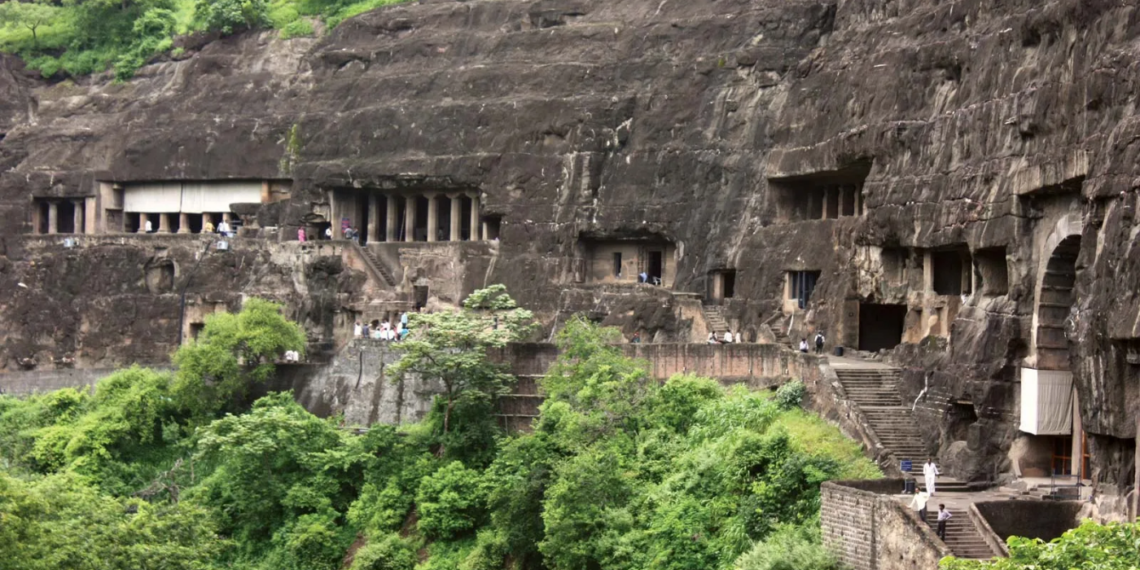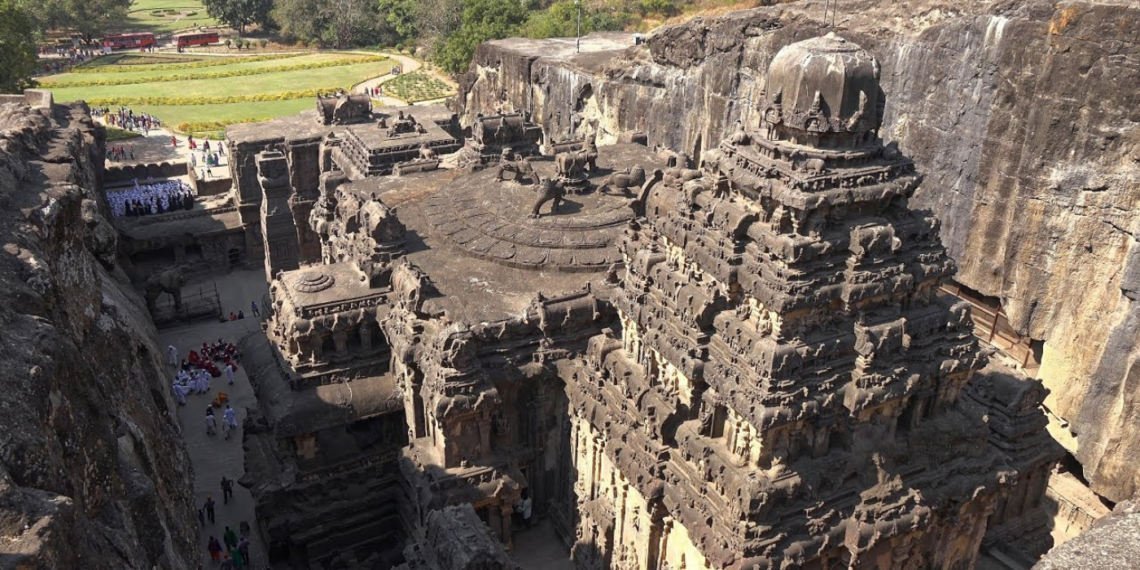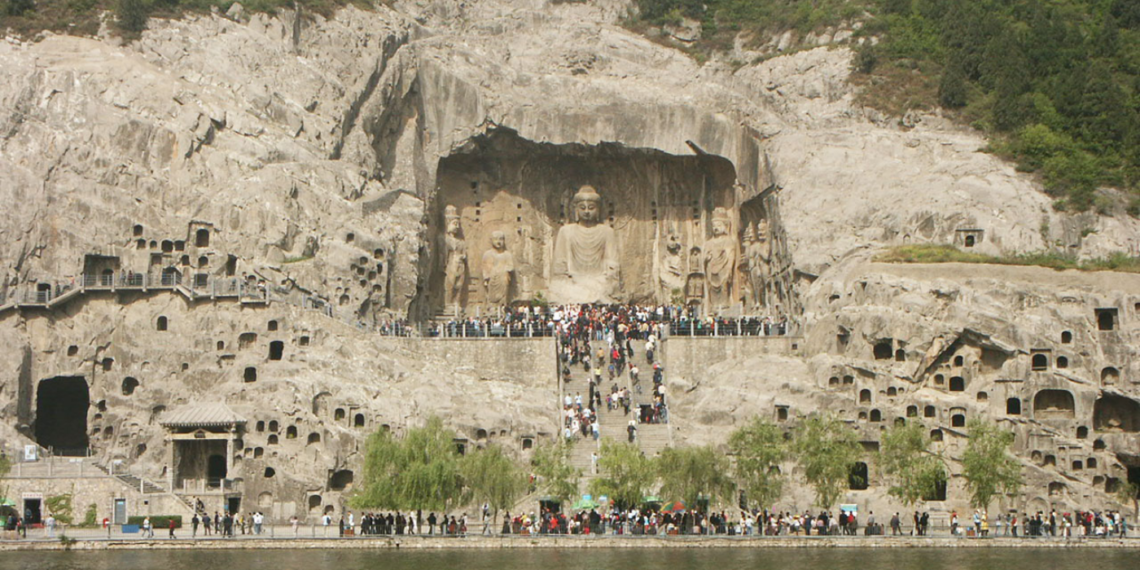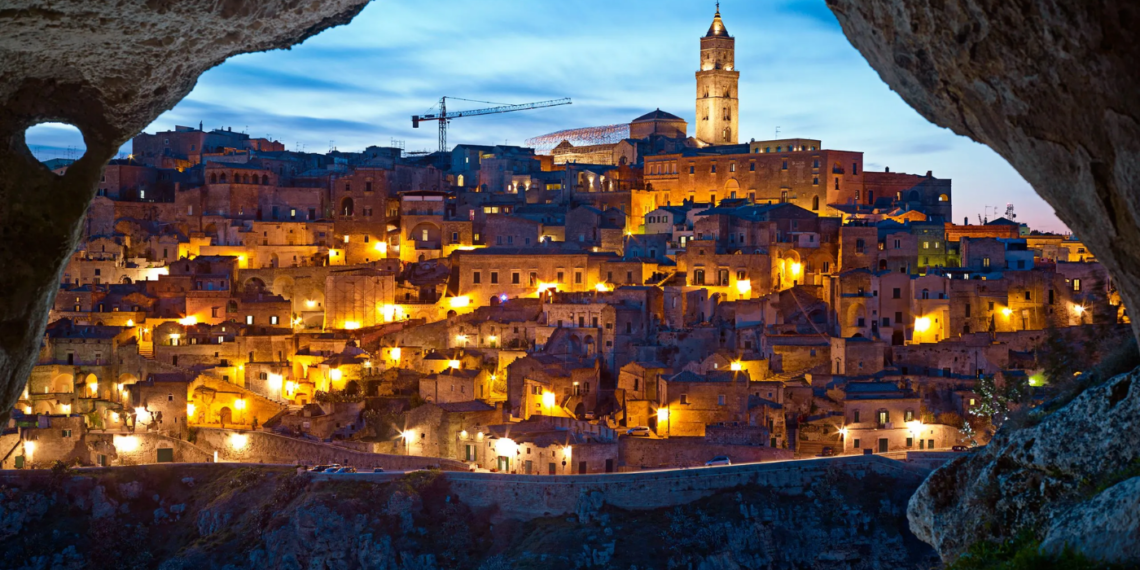Below the Earth’s surface, where shadows dance and ancient echoes whisper, lie some of the world’s most extraordinary marvels – cave temples. These hidden sanctuaries, sculpted by human hands and nature’s artistry, offer a journey into the spiritual and architectural wonders that have endured for centuries. Join us as we start on a below-ground journey to explore the top 10 cave temples from around the globe, where faith, art, and the attraction of the underground converge in breathtaking peace.
Most Amazing Cave Temples in the World
1) Ajanta Caves, India: Where Art Breathes

The Ajanta Caves, located in the state of Maharashtra, India, are a complex of 29 rock-cut Buddhist cave monuments, offering a window into ancient Indian artistry. Dating from the 2nd century BCE to about 650 CE, these caves are a tribute to the evolution of artistic expression in the Buddhist tradition. The caves are adorned with amazing paintings that represent various aspects of life, from divine tales to everyday existence.
The UNESCO World Heritage Site designation in 1983 underlines the exceptional historical and artistic significance of the Ajanta Caves. These caverns invite visitors to step back in time and marvel at the intersection of spirituality and art, where caves tell stories and the walls speak with centuries of devotion.
- Buddhist Themed Paintings: Many of the Ajanta Caves are adorned with intricate Buddhist-themed paintings. These paintings often depict scenes from the life of Buddha, Jataka tales (stories of Buddha’s previous lives), and the major events in the Buddha’s life. The vivid and detailed renderings of these stories provide a visual narrative of the core principles of Buddhism.
- Ceiling Frescoes: One of the most remarkable features of the Ajanta Caves is the ceiling frescoes found in Cave 1. The ceilings of these caves are often adorned with elaborate geometric and floral patterns. These patterns are intricately detailed and are a testament to the exceptional artistic skill of the cave’s creators.
- Bodhisattva Paintings: The caves also feature paintings of Bodhisattvas, enlightened beings who have chosen to remain in the material world to help others achieve enlightenment. The Bodhisattva paintings are known for their elegance and grace, with detailed depictions of their attire and serene expressions.
- Cave 17 – The ‘Horseshoe Arch’ Painting: Cave 17, often called the ‘Chaitya Griha,’ features an exceptional ‘horseshoe arch’ painting. This painting showcases the architectural elements and designs of the caves, offering an intricate look into the artistic and architectural style of the period.
- The ‘Golden Age of India’: The paintings within the Ajanta Caves are often associated with the Gupta period, known as the ‘Golden Age of India.’ During this era, art and culture flourished, and the paintings reflect the artistic and spiritual vibrancy of that time. The color palette, precision of detail, and overall composition are awe-inspiring.
- Restoration and Preservation: It’s essential to note that many of the paintings have undergone extensive restoration and preservation efforts. Over the centuries, these exquisite artworks faced natural deterioration and damage. Skilled conservators have worked tirelessly to maintain and restore these paintings, ensuring they remain visible to contemporary visitors.
The Ajanta Caves’ paintings continue to captivate art enthusiasts, historians, and spiritual seekers from around the world. These detailed and expressive works of art offer a glimpse into the rich history and spiritual depth of the region, where every brushstroke and pigment choice contributes to the narrative of humanity’s quest for enlightenment.
2) Ellora Caves, India: A Symbol of Religious Tolerance

The Ellora Caves, situated in the Indian state of Maharashtra, extend their architectural and spiritual embrace to a wide spectrum of religions. These caves, dating from the 6th to the 10th centuries CE, effectively blend Hindu, Buddhist, and Jain temples, showcasing a remarkable example of religious tolerance in the world.
The place comprises a total of 34 caves, each dedicated to a specific faith. Most famous among them is the awe-inspiring Kailasa Temple, which is carved out of a single piece of rock and stands as one of the most amazing architectural feats. As one explores the Ellora Caves, the intricate carvings, detailed sculptures, and the aura of spirituality within these ancient chambers are nothing short of breathtaking.
The Divine Trilogy:
The Ellora Caves consist of 34 caves, each dedicated to a specific faith. Cave numbers 1 to 12 house Buddhist monasteries and temples. These caves are replete with intricately carved sculptures and paintings, showcasing the life and teachings of Buddha. Cave 10, also known as the Viswakarma cave, is a stunning example of the Mahayana form of Buddhism, adorned with intricate carvings.
Moving on, caves 13 to 29 are dedicated to Hinduism. Cave 16, also known as the Kailasa Temple, is a crowning achievement. Carved out of a single piece of rock, it represents Mount Kailasa, the abode of Lord Shiva, and is a remarkable testament to ancient Indian architecture.
Cave numbers 30 to 34, the Jain caves, are a splendid testament to the Jain faith. These caves are adorned with intricate sculptures and carvings dedicated to the Jain Tirthankaras.
Religious Tolerance in Stone:
The Ellora Caves are a striking example of India’s long history of religious tolerance. The very fact that caves dedicated to three diverse faiths coexist within a single complex reflects the harmonious cohabitation of different religious ideologies in ancient India. It serves as a reminder that, even in a land of diverse beliefs, art and spirituality could flourish side by side.
Exquisite Carvings and Paintings:
The Ellora Caves are not just a symbol of religious tolerance; they are also a testament to human creativity and craftsmanship. The intricate carvings, the meticulously painted murals, and the architectural brilliance of the caves have drawn admiration from artists, historians, and travelers for centuries.
The Ellora Caves are a living testament to the spirit of tolerance and inclusivity that has defined India for millennia. These caves remind us that even in a world often divided by religious differences, art and spirituality have the power to unite and inspire. They stand as a symbol of the rich cultural heritage of India and the enduring power of creativity, echoing through the ages in stone, painting, and devotion.
3) Longmen Grottoes, China: Stone Carved Serenity

The Longmen Grottoes, located near the city of Luoyang in China, present another stunning example of ancient cave temples. With over 100,000 Buddhist cave temples and niches, the site houses more than 130,000 statues and 2,300 inscriptions. These caves, dating from the 5th to the 8th centuries CE, offer a serene escape into a world of carved calmness.
The Longmen Grottoes not only serve as a tribute to Buddhist devotion but also reflect the rich tapestry of Chinese art and history. Visitors are attracted to the delicate craftsmanship, the symbolism within each carving, and the spiritual ambiance that envelops the entire complex.
The Artistry in Stone:
The Longmen Grottoes comprise a complex of over 100,000 Buddhist cave temples and niches, adorned with more than 130,000 statues and 2,300 inscriptions. Each of these sculptures and inscriptions carries with it the whispers of centuries, bearing witness to the spiritual devotion and meticulous craftsmanship of generations past.
The Carved Serenity:
What sets the Longmen Grottoes apart is not just the sheer number of statues or the intricacy of the carvings; it’s the serenity that permeates this place. As you enter these caves, you’re greeted by the gaze of Buddha statues, each exuding a sense of inner peace. The sculptures range in size, from imposing colossi to delicate figurines, and they share a common theme – a sense of inner calm and compassion.
The walls of these grottoes are adorned with paintings and inscriptions that not only narrate Buddhist stories but also provide historical insights into the society of the time. The meticulous artwork, combined with the natural setting, creates an atmosphere of serenity that draws visitors into contemplation and reflection.
Symbolism in Every Niche:
Every niche, every carving, and every statue carries its own symbolism. Some represent the enlightenment of Buddha, while others depict deities and celestial beings. Amidst the serene faces, the intricately detailed garments, and the graceful postures, you can sense the profound connection between art and spirituality.
The Remarkable Preservation:
The Longmen Grottoes have benefited from meticulous preservation efforts. These efforts have not only safeguarded the ancient art and heritage but have also made the site accessible to generations of visitors. The longevity of these caves is a testament to human dedication, both in their creation and their preservation.
5) Batu Caves, Malaysia: A Hindu Haven in Limestone

Batu Caves, situated just north of Kuala Lumpur in Malaysia, offer a distinct fusion of natural wonder and spiritual devotion. These limestone caves are home to a series of Hindu temples and shrines, making them a significant pilgrimage site and a popular tourist destination.
The grand entrance, guarded by a colossal golden statue of Lord Murugan, sets the stage for the religious excitement and the unique atmosphere within the caves. Visitors climb a steep flight of stairs to reach the inner sanctums, where vibrant colors, intricate statues, and the spiritual aura create an unforgettable experience.
The Grand Entrance:
The journey to the Batu Caves begins with a grand entrance that captures the essence of this spiritual haven. A colossal golden statue of Lord Murugan, standing at 42.7 meters (140 feet) tall, guards the steps leading to the caves. The sight of this magnificent deity serves as an awe-inspiring prelude to what lies within.
The Caves and Temples:
As visitors ascend a steep flight of 272 steps, they enter into a realm where natural beauty and religious devotion coexist. The Batu Caves consist of a series of cave temples and shrines, with the main cave, known as the Cathedral Cave or Temple Cave, being the most prominent. This cavernous space is awe-inspiring, with its high vaulted ceilings, vibrant Hindu statues, and the feeling of being embraced by the Earth itself.
The Cathedral Cave is dedicated to Lord Murugan, the Hindu god of war and victory, and it is a place of pilgrimage for Hindus not only from Malaysia but from around the world. The atmosphere inside is a vibrant mix of devotion, incense, and the echoes of prayers. The cave’s walls are adorned with intricate sculptures and paintings that depict various episodes from Hindu mythology, creating an immersive experience for visitors.
Art and Painting:
One of the most striking aspects of the Batu Caves is the art and painting that adorns the cave walls. These artistic representations showcase episodes from Hindu scriptures, depicting gods and goddesses, celestial beings, and epic battles. The vibrant colors, meticulous details, and the use of light and shadow create a sense of wonder and reverence within the cave.
The art and paintings within the Batu Caves provide a unique opportunity to learn about Hindu mythology and the stories that have shaped the religious beliefs of millions. They serve not only as religious symbols but also as a visual narrative of the culture and traditions of the Hindu community in Malaysia.
Thaipusam Festival:
The Batu Caves also gain international recognition during the annual Thaipusam festival. This Hindu festival, celebrated with great fervor, involves devotees carrying kavadis (elaborate structures adorned with spikes and ornaments) as acts of penance and devotion. The festival draws thousands of participants and spectators who come to witness the colorful and often intense rituals, making it a unique and memorable experience.
6) Matera Sassi Cave Dwellings, Italy: Ancient Abodes

The Matera Sassi Cave Dwellings in Italy offer a different perspective on cave architecture. These over 9,000 cave dwellings, which date back to the 9th century CE, were inhabited until the 1950s. They tell a story of human adaptation to natural surroundings, using caves as homes, and eventually leading to the formation of an entire underground city.
Today, the Sassi of Matera is a UNESCO World Heritage Site and a popular tourist destination. They provide insight into the evolution of human habitation and the intricate relationships between architecture and the environment.
The Origins of Matera Sassi:
These unique cave dwellings, known as “Sassi,” date back to the 9th century CE, although some evidence suggests human habitation even earlier. Initially carved into the soft, golden tufa rock of the region, these dwellings were ingeniously designed to adapt to the rugged landscape, offering shelter from the elements and invaders.
Carved into the Past:
The Sassi of Matera showcase an architectural marvel that blends harmoniously with the natural environment. The maze-like streets and passageways, the chiseled facades, and the labyrinthine cave homes take visitors on a journey back in time. Walking through the narrow alleys, it’s easy to envision the lives of the people who once called these caves home.
The caves themselves were ingeniously designed, featuring niches and chambers for various functions – from bedrooms to kitchens, churches, and stables. Remarkably, the Sassi provided a perfect microclimate, maintaining a stable temperature throughout the year, making them comfortable in both scorching summers and frigid winters.
The Art of the Sassi:
The Sassi of Matera also served as a canvas for artistic expression. The interiors of many dwellings, particularly the churches and chapels, are adorned with exquisite frescoes and paintings. These works of art, though hidden from the outside world, tell stories of faith and community. The colors, figures, and motifs are a testament to the spiritual and cultural richness of the inhabitants.
In more recent history, Matera’s Sassi went through a period of neglect, prompting a mass migration to more modern homes. However, they were not forgotten. In 1993, UNESCO recognized their significance by designating the Sassi of Matera as a World Heritage Site. This recognition sparked a revival, with efforts to restore and preserve these ancient dwellings.
An Enduring Legacy:
Today, Matera’s Sassi are not just a historical site but a thriving community and a vibrant cultural hub. Visitors can explore the caves, engage with local artisans, and even stay in restored cave dwellings turned into cozy hotels and restaurants. The Sassi represent a harmonious coexistence of past and present, tradition and innovation, nature and architecture.
The Matera Sassi Cave Dwellings, with their rich history and enduring spirit, invite travelers to journey through time, reminding us of the incredible adaptability of the human spirit and the boundless potential of art and architecture. They are not just ancient abodes; they are a testament to the enduring beauty and resilience of the human story.
7) Goreme Open Air Museum and Cappadocia Cave Churches: Where Faith Meets Geological Wonder

Goreme Open Air Museum, Turkey: A Testament to Faith
The Goreme Open Air Museum, located in the town of Göreme in Turkey, is a UNESCO World Heritage Site comprising a number of rock-cut churches and monasteries dating from the 10th to 13th centuries CE. These caves served as places of worship and contemplation, showcasing unique architectural features and religious significance.
As visitors explore the churches and monasteries, they encounter stunning masterpieces that represent historical scenes and moments from early Christianity. The Goreme Open Air Museum stands as a remarkable tribute to faith, artistic expression, and the enduring connection between spirituality and architecture.
Cappadocia Cave Churches, Turkey: A Geological Wonder
The Cappadocia Cave Churches, located in the region of Cappadocia, Turkey, date from the 4th to the 13th centuries CE. What makes these cave churches unique is their setting among the “fairy chimney” rock formations. The churches, monasteries, and dwellings carved into these otherworldly rock formations offer a blend of geological wonder and spiritual significance.
The unique geological formations of Cappadocia are as fascinating as the architecture within these caves. Visitors can explore a surreal landscape of ancient faith and unearthly landscapes.
In the universe of spiritual and architectural wonders, the 10 most amazing cave temples from around the world stand as timeless tributes to human ingenuity and devotion. These Ancient Sanctuaries, each unique in their cultural and historical context, offer a glimpse into the profound connection between humanity and the divine. From the ancient beauty of India’s Ajanta and Ellora Caves to the mesmerizing rock-hewn churches of Lalibela in Ethiopia, these cave temples beckon travelers to travel on a spiritual path of the soul. Their walls, adorned with art and inscribed with history, remind us that the allure of cave temples endures, transcending time and geography.




